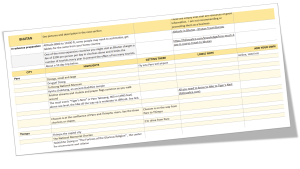Scenic Routes, Cape Town & Adventures, South Africa
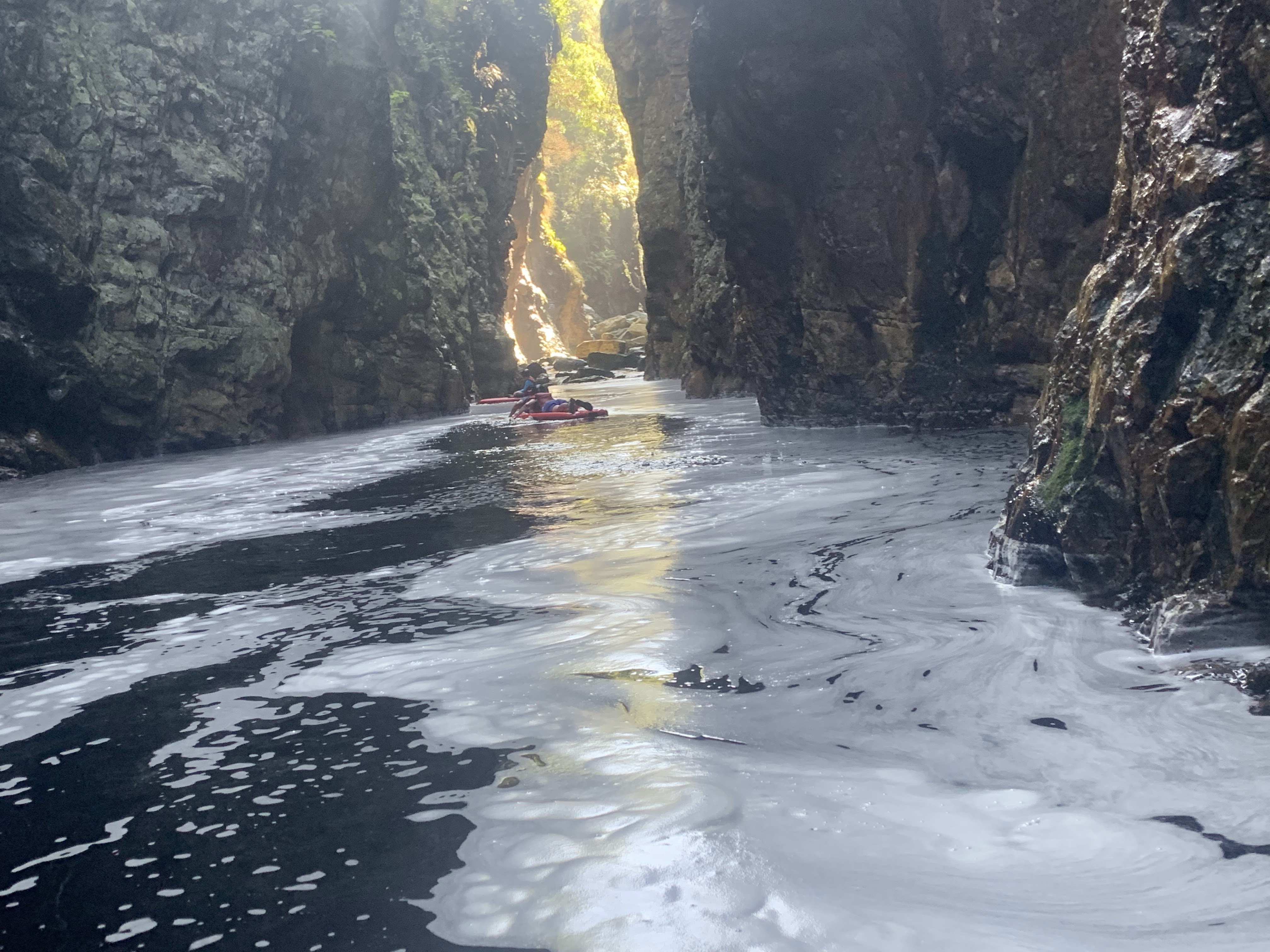
Cover: Storms River Gorge in the Tsitsikamma National Park, South Africa
South Africa is a rich amalgamation of culture, vibrant color, rituals, beautiful landscapes, nature and wildlife. The country which gives you a glimpse of how wildlife untrammeled by human activity might be. Whether you are there to spot the big five or watch penguins on the beach, walk around in the colorful towns and visit sobering museums, you will come away with awe and a first-hand understanding of what it means to fight for basic human rights and dignity.
Zoom in and out to view pins. Use the Share icon on top right corner of the map to send it to your phone or email.
Click on the blue pins to see the name of the place.
What’s on this page?
IMPORTANT
- For any serious travel planning and to enhance your experience with the pictures, view all blog pages on a laptop/large screen versus on the phone.
- All the text content is in the collapsible sections (+ to open, – to close).
- Every picture on the site has a caption that is not visibly displayed. How to see the name or location in pictures of interest? If using a laptop, hover over the image. If using a mobile, hold finger down on the image. (This instruction may vary with browsers, and type of device such as iphone and Andriod).
NEED HELP WITH TRIP PLANNING?
You can use the Highlights section to create your own itinerary.
But no time or inclination to delve into details? No worries!
I will curate and customize a trip for you, based on your interests and needs. You will receive a well-planned day-by-day itinerary and travel advice.
Visit Services & About for more details.
Tidbits
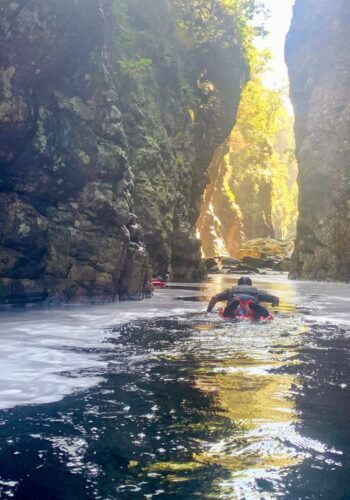
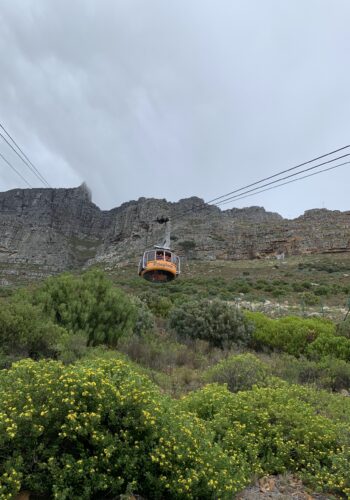
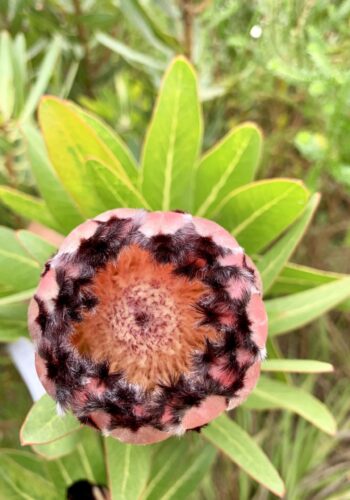
TIDBITS (+ to OPEN, - TO CLOSE)
Driving is to the left.
Crime is very high in South Africa and so whether driving or in general, be very vigilant.
Most common type of power outlet in South Africa is of Type M. The voltage used is 220-240V, and the frequency is 50Hz.
There are about 11 languages spoken in South Africa and English is widely understood and spoken with tourists.
Currency used in South Africa is the Rand. Credit cards are quite widely accepted but you need to be aware of any foreign transaction fees charged by your credit card company.
Here is a month-to-month guide on weather and events for travel to South Africa.
About the blog
The blog on South Africa is going to have two parts as it has many activities and places to sight-see. Thanks to Malathy Chandrasekhar from Dallas for writing in the narrative section, all about their amazing experiences along the Garden route in South Africa, and for the links and photographs she provided in that section, making my job easier.
All blog pages are best viewed on a laptop/large screen versus on the phone, especially for any serious travel planning, to minimize scrolling and to appreciate its larger-than-life pictures. Depending on the device you are using, hover or hold down on an image for its name/location. Note: There are other similar websites and so don’t miss the s and the u in Travels to Savour (travels to savour 🙂 ).
Highlights
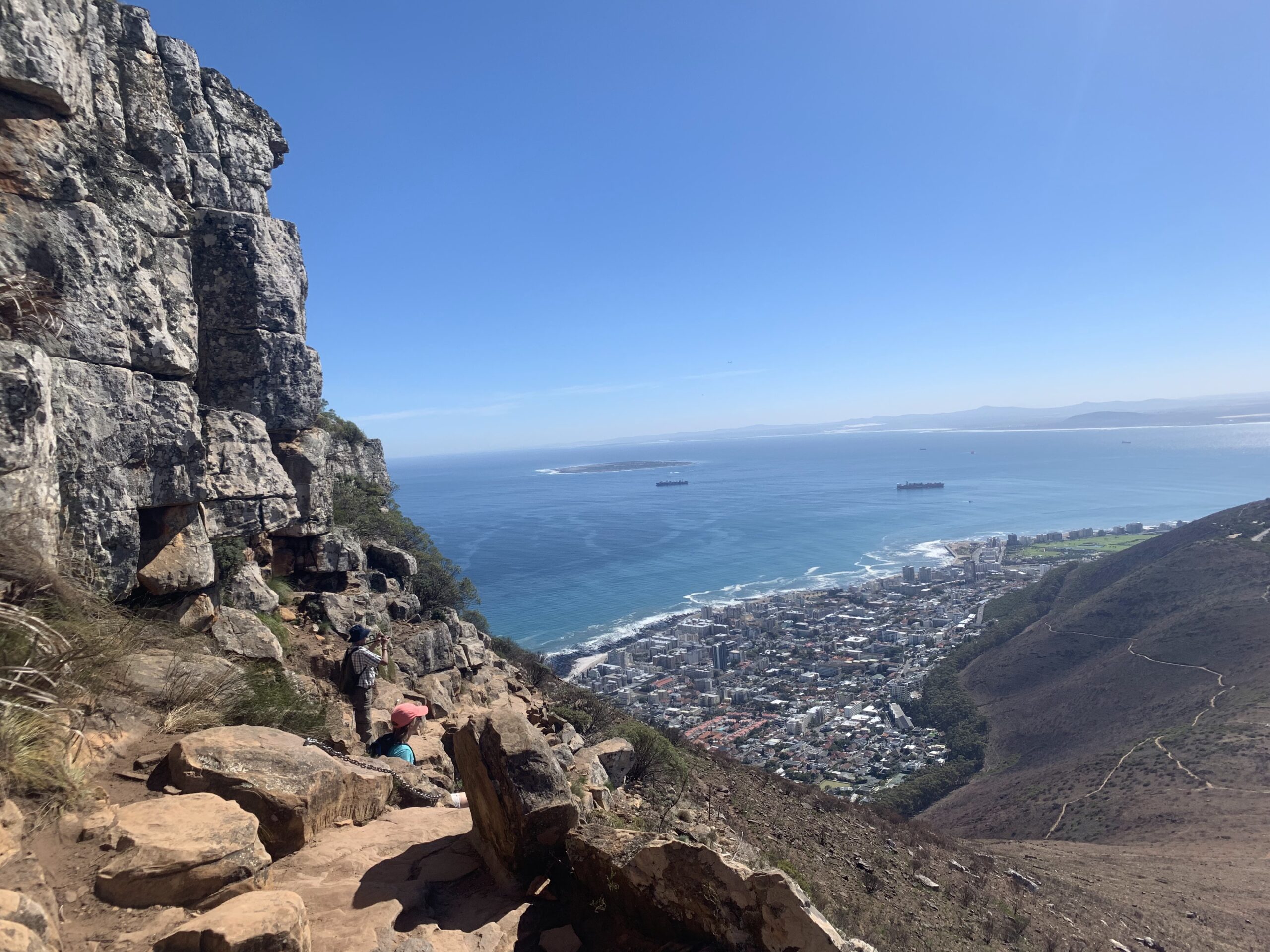
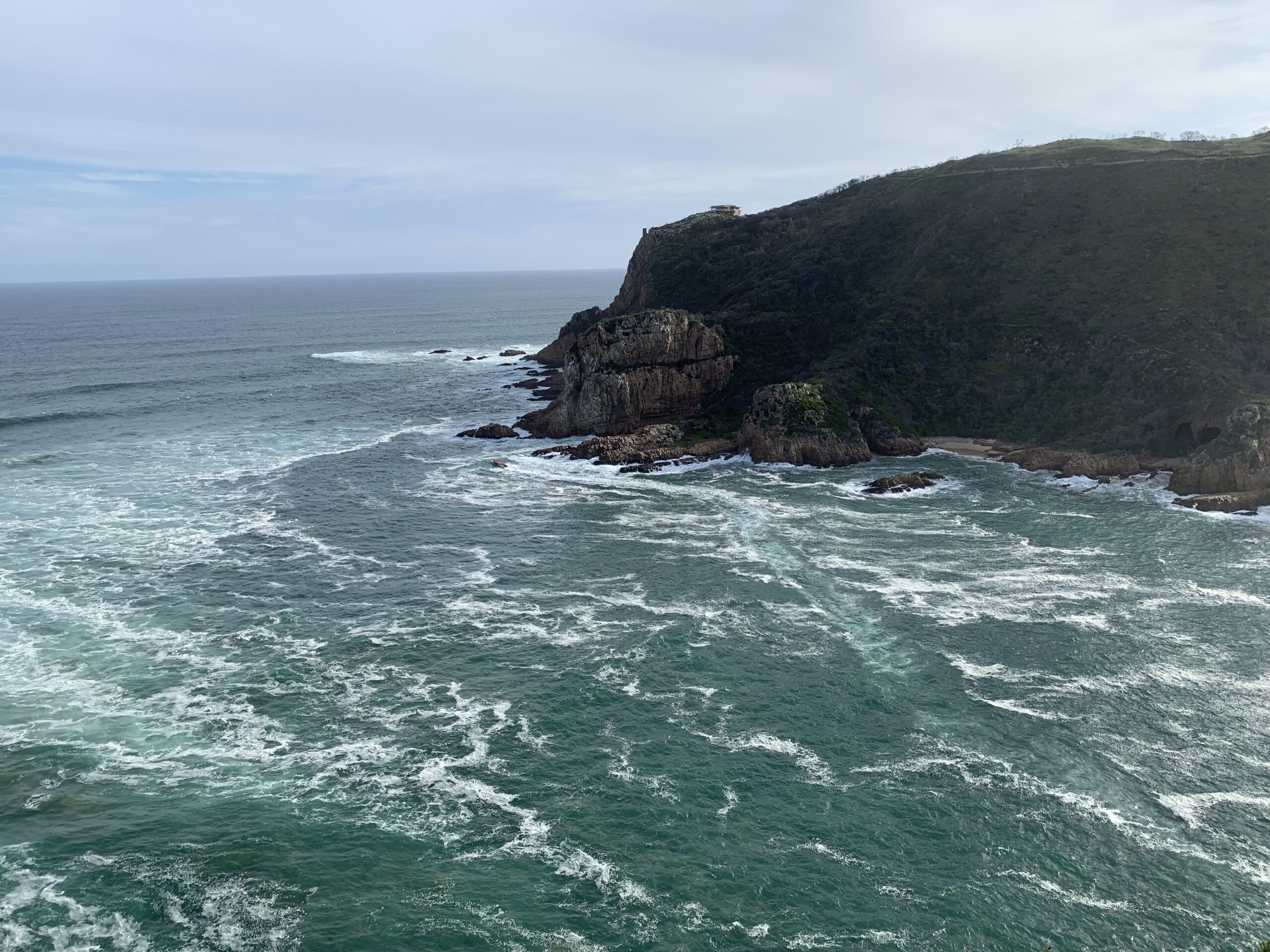
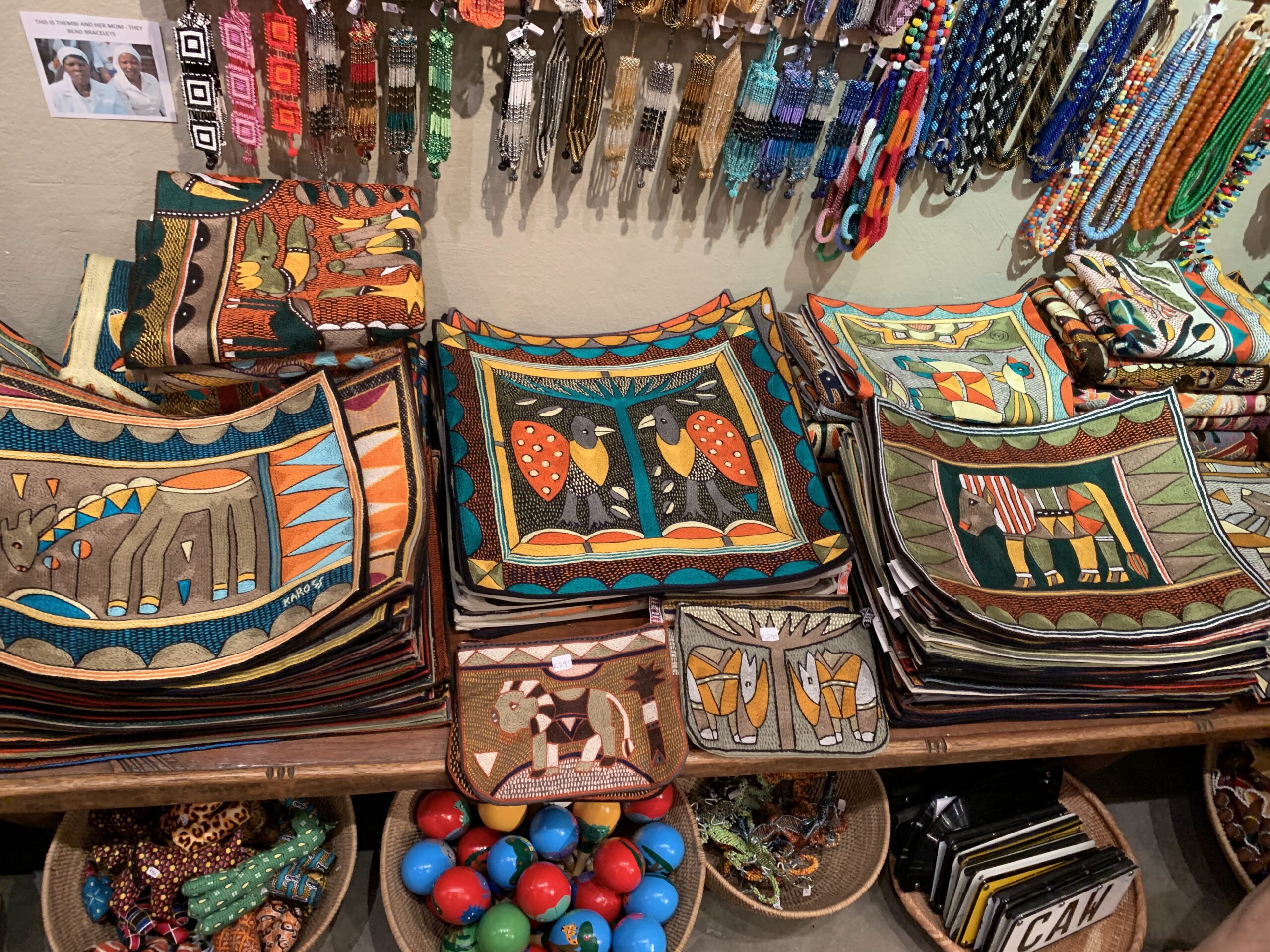
HIGHLIGHTS (+ to OPEN, - TO CLOSE)
South Africa offers some breathtaking panoramic routes that showcase the country’s stunning landscapes. One of the most famous panoramic routes is the Panorama Route, located in the Mpumalanga province. Studded with several waterfalls, spectacular viewpoints and geographical phenomena and a breathtaking canyon, it is a very popular tourist destination. The Panorama Route is easily accessible from the town of Graskop, which serves as a gateway to the various attractions. Here are some highlights of the Panorama Route:
- Blyde River Canyon: This is one of the largest canyons in the world and offers spectacular views of sheer cliffs, lush vegetation, and the winding Blyde River below. God’s Window, located within the canyon, provides awe-inspiring views of the Lowveld region.
- Bourke’s Luck Potholes: These natural rock formations are the result of centuries of erosion by the confluence of the Treur and Blyde Rivers. The swirling whirlpools have carved cylindrical potholes and is a geological wonder.
- Three Rondavels: These three round mountain tops resemble traditional African huts or rondavels. They overlook the Blyde River Canyon.
- Pilgrim’s Rest: This historic town was established during the gold rush in the 19th century. There is a museum about its gold mining history.
- Graskop Gorge: A suspension bridge over the gorge, allows visitors to enjoy beautiful views of the surrounding forests and waterfalls.
- Along the Panorama Route, there are several amazing waterfalls – Lisbon Falls, Berlin Falls, and Mac-Mac Falls.
- Hiking Trails: There are a number of hiking trails available, ranging from easy walks to more challenging treks.
Kruger National Park is one of Africa’s largest game reserves and is located in northeastern South Africa, stretching across the provinces of Mpumalanga and Limpopo. It’s renowned for its diverse wildlife and is a popular destination for safari enthusiasts from around the world. More about this wonderful park can be found in the blog Kruger and Johannesburg, a firsthand narration.
The Garden Route is a popular scenic drive and tourist route along the southern coast of South Africa, stretching from Mossel Bay in the Western Cape to Storms River in the Eastern Cape. It’s renowned for its stunning landscapes, diverse ecosystems, and plethora of outdoor activities. Whether you’re seeking adventure, relaxation, or simply want to immerse yourself in stunning scenery, the Garden Route offers something for everyone. It’s a journey that promises unforgettable experiences and memories to last a lifetime. Read the below narrative on the Garden Route and Cape Town by Malathy that will transport you into a realm of wonderful experiences.
Cape Town is one of South Africa’s most vibrant and picturesque destinations, whether you’re interested in history, nature, culture, or culinary delights.
- Table Mountain: This is of course a prominent landmark of Cape Town. Hiking up offers breathtaking views of the city and coastline. One can also take the Table Mountain Aerial Cableway.
- Cape Point and the Cape of Good Hope: Located within the Table Mountain National Park, Cape Point is known for its dramatic sea cliffs, scenic hiking trails, and historic lighthouse. The nearby Cape of Good Hope is a must-visit for its beauty.
- Robben Island: This UNESCO World Heritage Site has guided tours – it was a political prison during the apartheid era, where Nelson Mandela was incarcerated for 18 years. A necessary insight into South Africa’s history and struggle for democracy.
- Victoria & Alfred Waterfront offers a mix of shopping, dining, entertainment, and cultural attractions. Visitors can take harbor cruises, visit the Aquarium, explore the Zeitz Museum of Contemporary Art Africa (MOCAA).
- Cape Winelands: A short drive from Cape Town, the Winelands region boasts of lovely vineyards and historic towns.
- Kirstenbosch National Botanical Garden: It is renowned for its diverse flora and outdoor concerts. There are themed gardens and treetop canopy walks.
- Boulders Beach is the home to a colony of endangered African penguins and offers an amazing observe opportunity to see these creatures up close. Visitors can also swim in the bay.
- Bo-Kaap: This vibrant neighborhood is known for its colorful houses, cobbled streets, and Cape Malay heritage. Explore the Bo-Kaap Museum, and sample traditional Cape Malay cuisine.
- District Six Museum: This museum provides insight into the social and political history of Cape Town’s former multicultural neighborhood.
- Chapman’s Peak Drive: A popular route for road trips and leisurely drives, Chapman’s Peak Drive is dotted with viewpoints and picnic spots. It offers breathtaking views of the Atlantic Ocean and rugged cliffs.
Vegetarian Food
I will be remiss if I don’t mention how many of my Indian friends who visit parts of Africa come back in bliss with respect to the vegetarian food they have eaten! 🙂 Even in game reserves, there are local cooks who regularly make the Indian bread called Chapati and it is served nice and hot on the lunch/dinner table with accompanying curries. How is that? Read the sections below….Of course, there is a lot of other food that is specifically local in terms of ingredients and cooking style, but I dedicate a section to the Indian style of food as everyone there is commonly familiar with it (like in Britain).
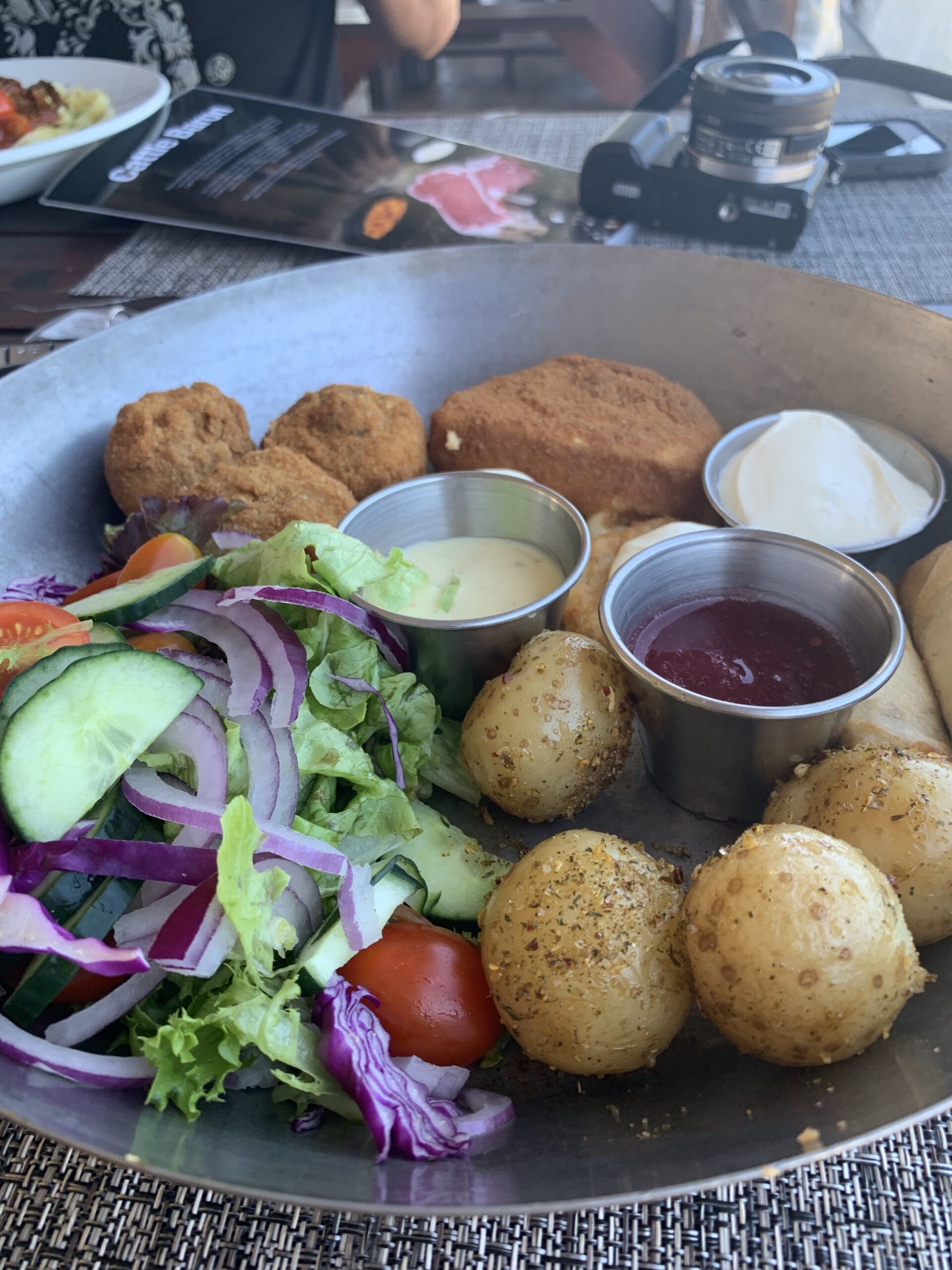
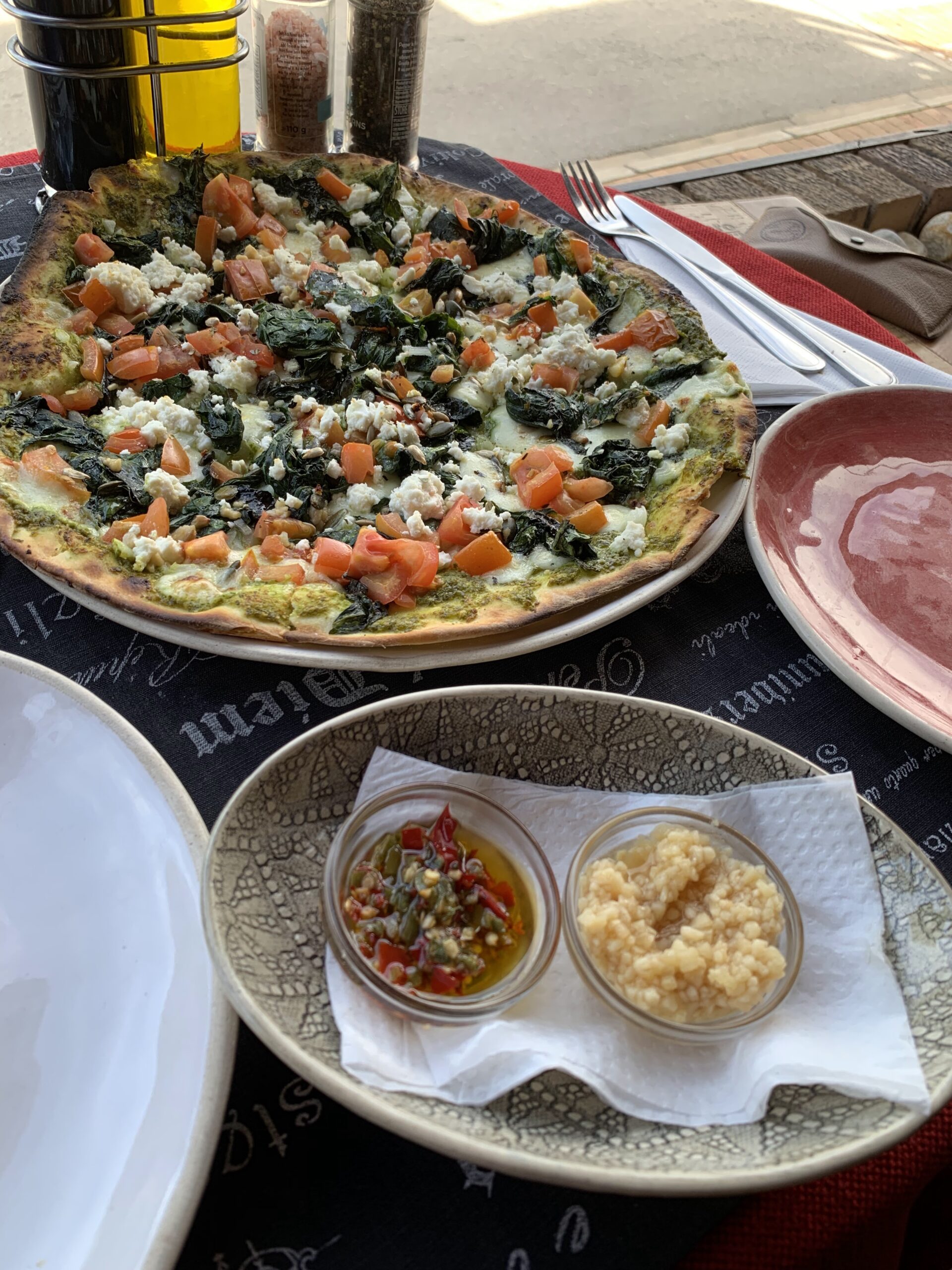
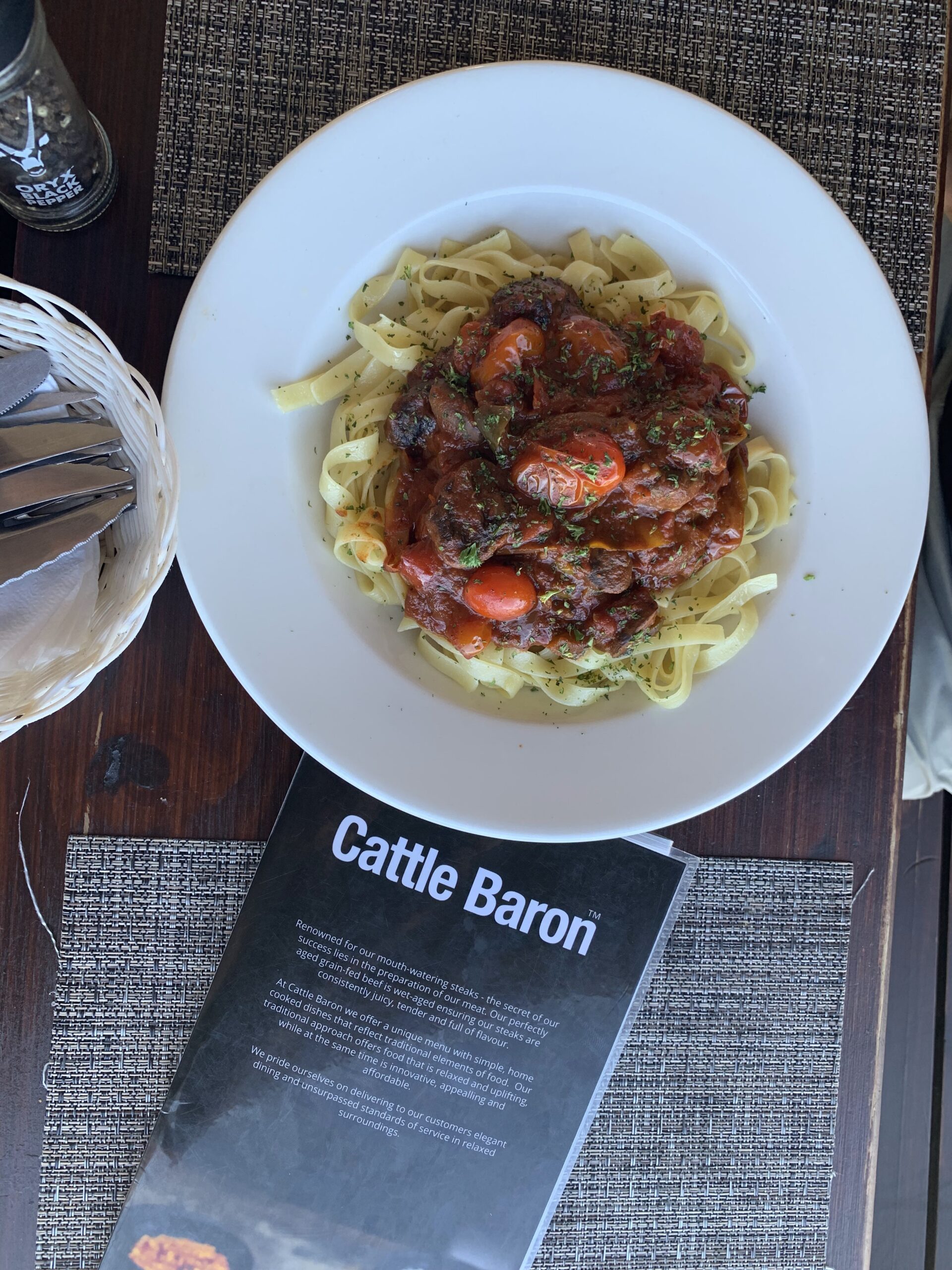
VEG FOOD (+ to OPEN, - TO CLOSE)
While meat may feature prominently in South African cuisine, vegetarians still can enjoy a diverse range of dishes, and many restaurants and eateries cater specifically to vegetarians and vegans.
- Vegetable Bunny Chow: Bunny Chow is a popular South African dish consisting of a hollowed-out loaf of bread filled with curry. While traditional Bunny Chow often contains meat, many restaurants offer vegetarian versions filled with flavorful vegetable curries.
- Bobotie: This iconic South African dish is typically made with spiced minced meat, but vegetarian versions using lentils, beans, or tofu are also available. Bobotie is usually served with rice and topped with a mixture of beaten egg and milk.
- Samp and Beans: Samp is a type of dried corn kernel, and when cooked with beans, it creates a hearty and nutritious dish. Vegetarian versions of samp and beans often include a variety of vegetables and spices for added flavor.
- Vegetable Biryani: South Africa’s Indian-influenced cuisine offers vegetarian options such as vegetable biryani, a fragrant rice dish cooked with mixed vegetables, spices, and sometimes nuts or dried fruits.
- Vegetable Samosas: These savory pastries filled with spiced vegetables are a popular snack or appetizer in South Africa. They can be found in many bakeries, markets, and Indian restaurants.
- Pap and Chakalaka: Pap, a type of maize porridge, is a staple food in South Africa. It’s often served with chakalaka, a spicy vegetable relish made with tomatoes, onions, peppers, and beans. This dish is simple yet flavorful and satisfying.
- Veggie Burgers and Wraps: Many restaurants and cafes in South Africa offer vegetarian versions of classic burgers and wraps made with plant-based patties, grilled vegetables, and tasty sauces.
- Vegetarian Braai (Barbecue): Enjoy a braai of vegetable skewers, grilled mushrooms, corn on the cob, and halloumi cheese.
- Vegetarian Cape Malay Curry: Cape Malay cuisine, influenced by the cooking of the Cape Malay community, offers flavorful vegetarian curries made with lentils, chickpeas, or vegetables such as butternut squash and sweet potatoes.
- Fresh Fruits and Salads: There is no shortage of fruits and salads. Look out for exotic fruits like mangoes, papayas, and guavas, as well as salads made with local ingredients.
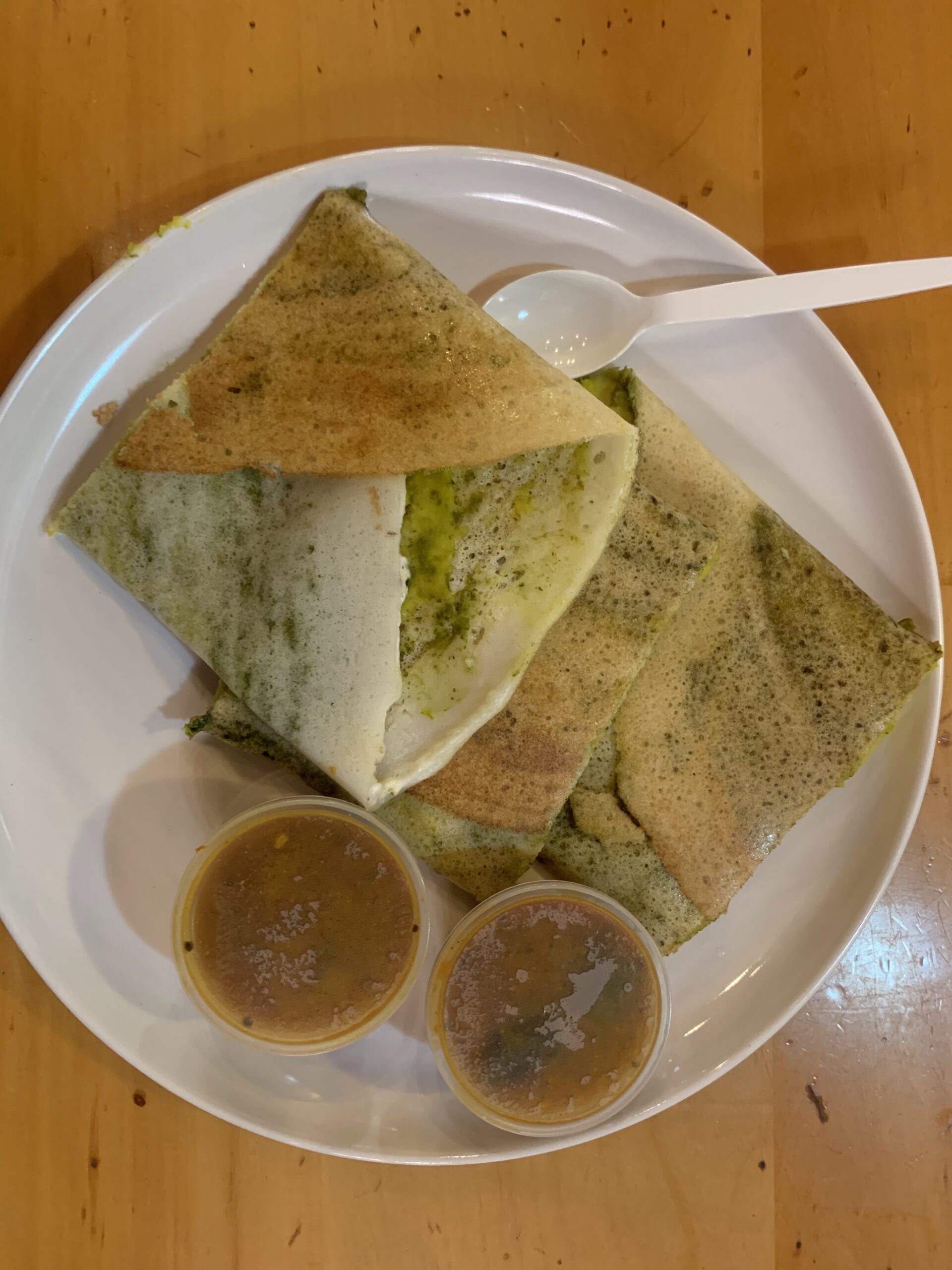
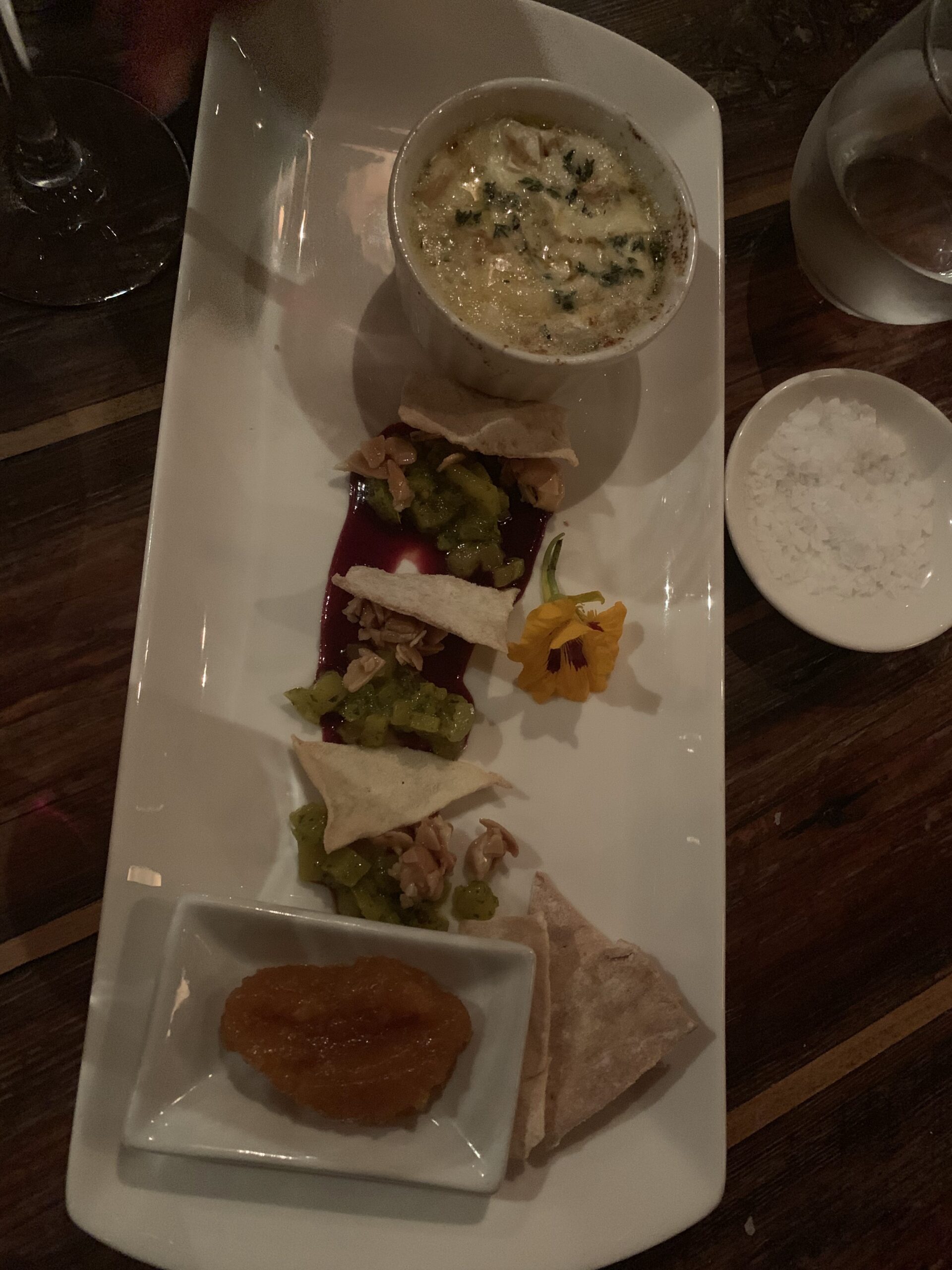
Indian influence in African cuisine has led to the adaptation and fusion of Indian spices, cooking techniques, and dishes with local ingredients and flavors, across the continent, particularly in regions where Indian migrants have settled or where Indian spices and cooking techniques have been introduced through trade and colonialism. Indian food in some of the African countries:
South Africa: South African cuisine exhibits a significant Indian influence, particularly in the province of KwaZulu-Natal, where many Indian migrants settled during the 19th and 20th centuries. Dishes such as bunny chow, samosas, and biryanis are popular.
Kenya: In Kenya, Indian influence is evident in dishes like pilau, samosas, and chapatis. Indian spices such as cumin, coriander, turmeric, and cardamom are commonly used in Kenyan cooking, reflecting the influence of Indian cuisine.
Tanzania: The cuisine of Tanzania also reflects Indian influence in dishes like pilau, biryanis, and chapatis alongside traditional Swahili fare. Indian snacks like bhajias (vegetable fritters) are also popular street food items.
Uganda: Ugandan cuisine features Indian-inspired dishes such as chapatis, which are often served with stews or curries. Indian spices and ingredients like ginger, garlic, and chili peppers are commonly used in Ugandan cooking, from the influence of Indian cooking.
Zambia: In Zambia, Indian influence can be seen in dishes like mandazi (a type of fried bread similar to Indian poori), samosas, and pilau rice. Indian spices and flavors have been incorporated into Zambian cuisine, creating a unique fusion of Indian and African culinary traditions.
Narrative and Pictures of The Garden Route and Cape Town
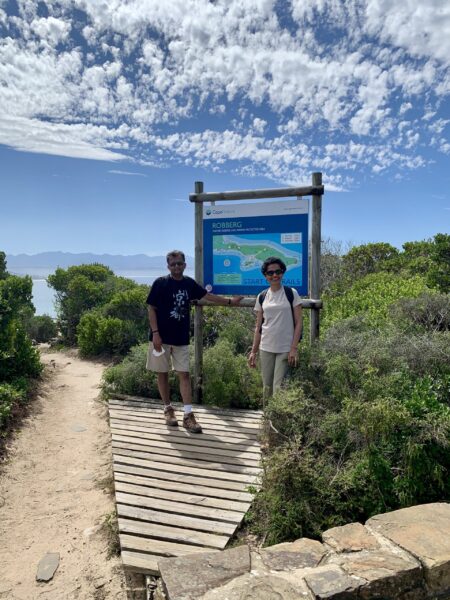
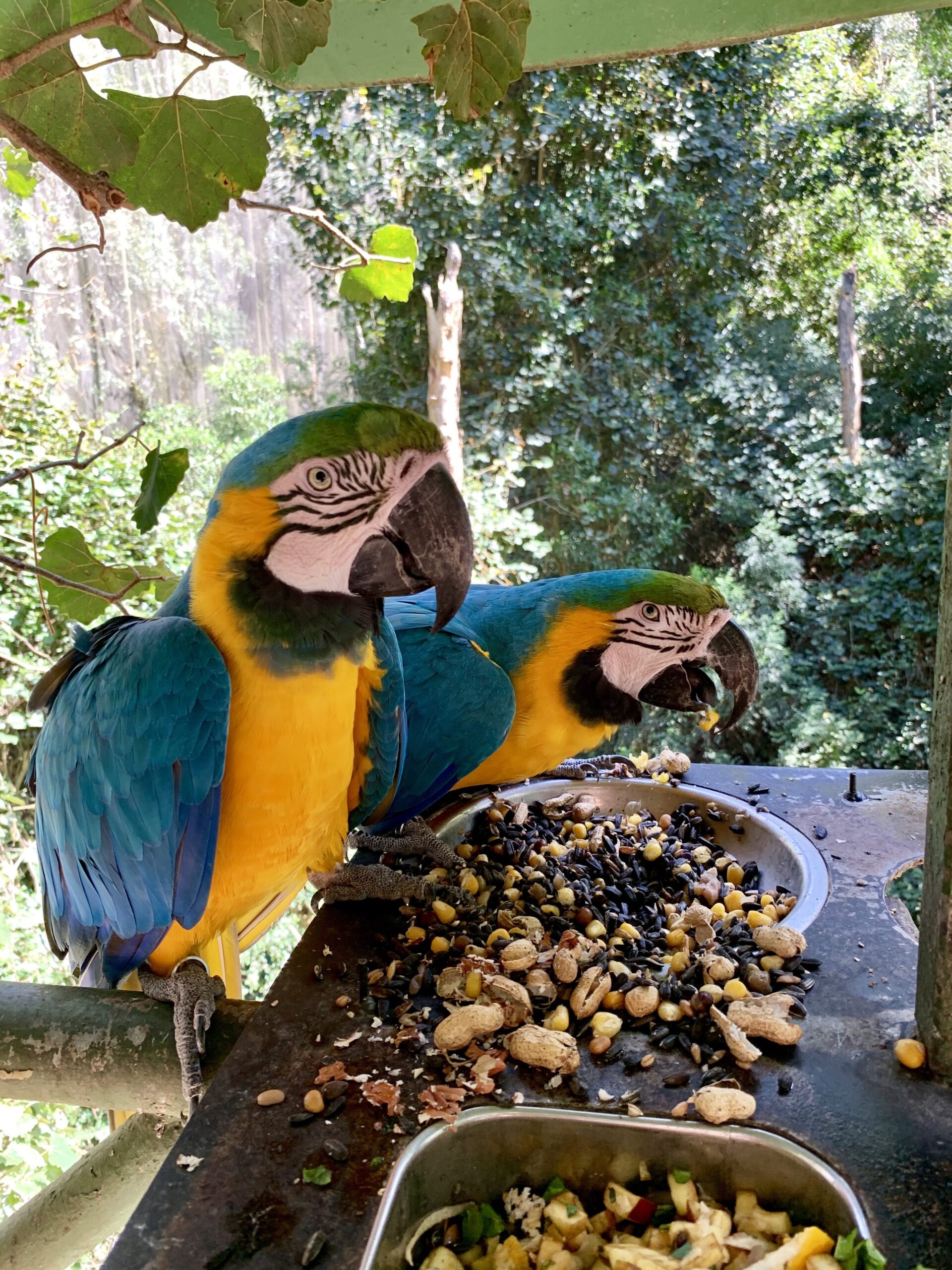
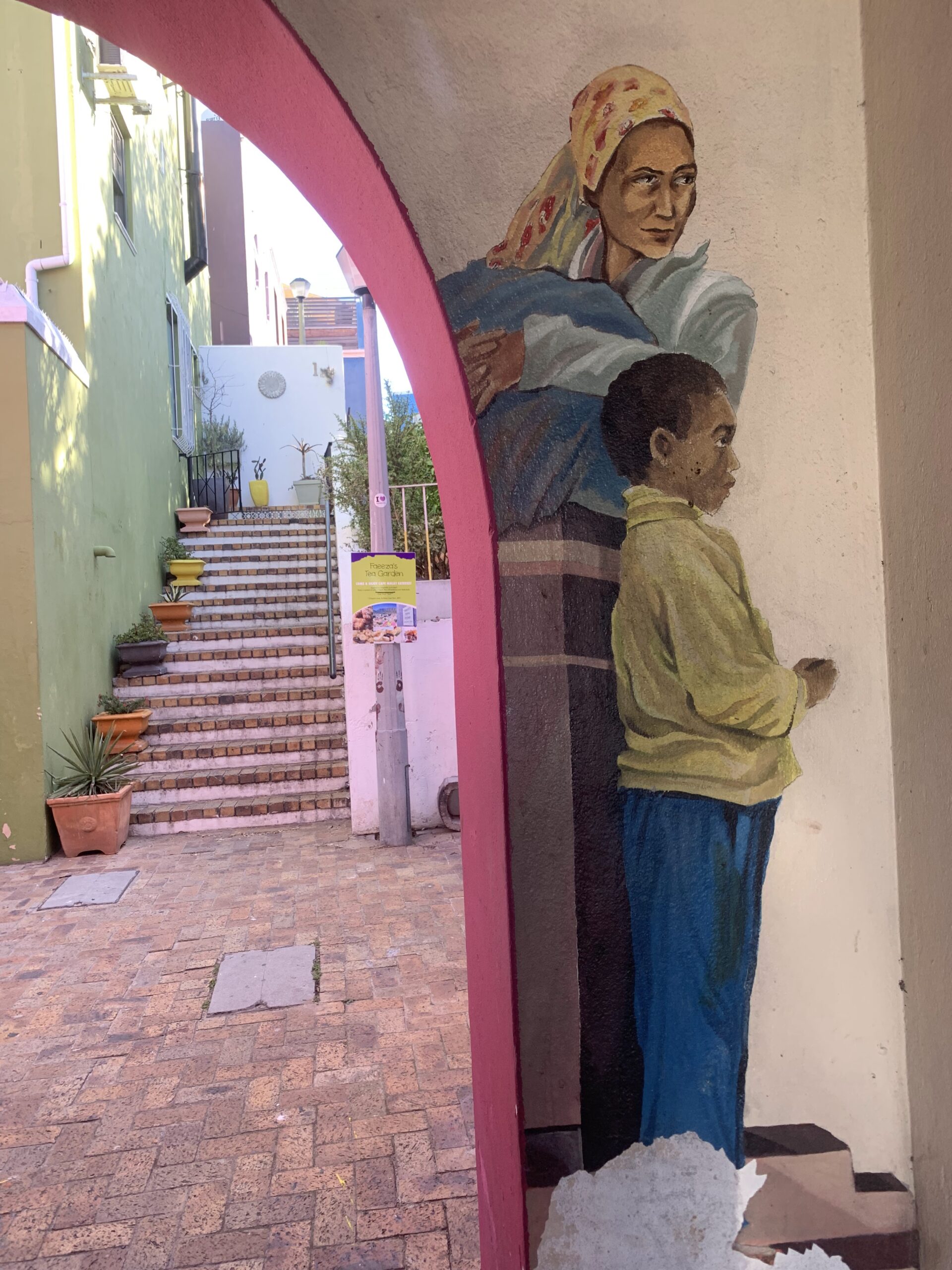
After experiencing Kruger NP, the Panorama Route, and Johannesburg, we flew south on SA’s local airline Kulula Air to a town called George. From here, we began what is called the Garden Route.
The Garden Route is a coastal corridor officially extending from Mossel Bay in the Western Cape through to the Tsitsikamma forests in the Eastern Cape. Covering ancient forests, glistening rivers, beaches, lakes, and plenty of mountain scenery, this strip of land is world-famous and attracts plenty of visitors both national and international throughout the year. Popular as a holiday destination as well as a permanent one, the Garden Route is like none other. Visitors will find unique flora and fauna (hence the name) encompassing spectacular indigenous fynbos (a distinctive type of vegetation found only on the southern tip of Africa).
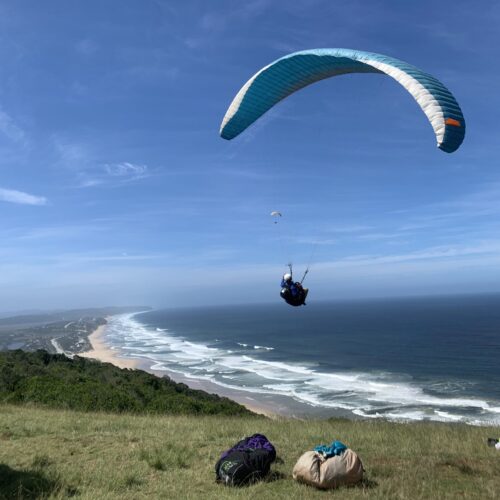
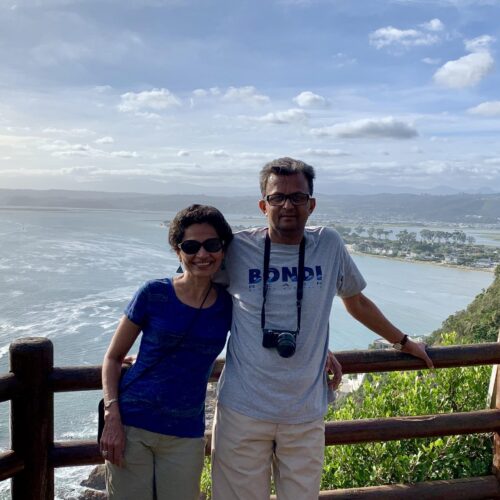
Day 1:
We rented a car at the airport and headed to Knysna. Within 2 hours of air travel from Johannesburg, a completely different landscape unfolded before us – sandy beaches glistening in the morning sun, backed by northward cliffs over which the fringe of the forest reaches down to sea level. The stops at Wilderness, Kaaimans, and Sedgefield on Highway N2 were my favorites. The dare-devil streak in us showed up suddenly and we went on an adrenaline-rush tandem paragliding ride over the mountains, beach, and ocean.
After a whole day of what normally takes an hour to drive, we reached our accommodations in Knysna. I suggest you stay on the waterfront to enjoy the views of the quay, the little shops, the seagulls, and the wooden furniture that it is famous for. We wandered around, chatted with shopkeepers, had a leisurely dinner, and retired for the night.
Day 2:
We woke up early and walked along the beautiful beach between Brenton-on-Sea to Buffalo Bay. After working up an appetite, a delicious breakfast followed. We visited Knysna Heads and wondered if anything could be more scenic.
We then drove to visit the aviary called Birds of Eden. Its unique two-hectare dome (the world’s largest) spans over a gorge of indigenous forest. Currently it is home to over 3,500 birds from over 220 species, with the main focus being African birds.
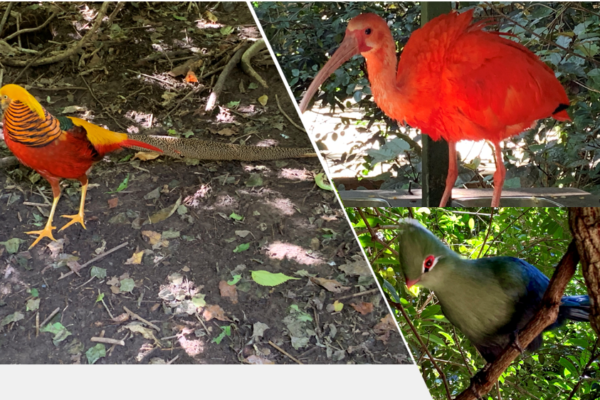
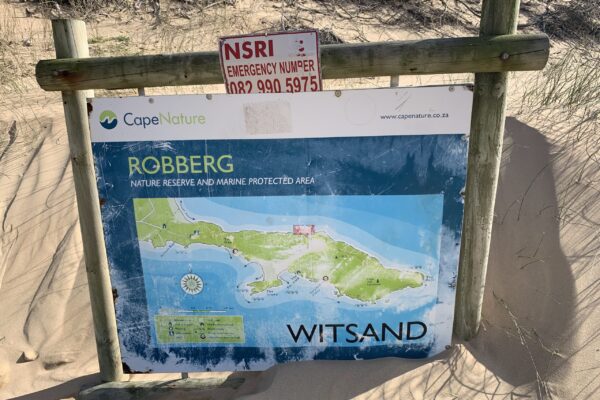
Day 3:
We packed our backpacks and went to Robberg Nature Preserve and did a strenuous hike called the Point Circuit Route, with our local friends Ann and Lisa.
The hike is 9 kilometers long around a peninsula jutting out into the Indian Ocean and is rated as one of the top things to do in Plettenberg Bay. The best of the hike is the ever-changing scenic views: rocky coastline, colony of cape fur seals making a racket, secluded beach (if you are lucky, you may even spot a whale) were the highlights of this fabulous hike.
After a sumptuous lunch at the Lookout Deck and a well-deserved siesta, we walked in secluded beaches along Ann’s home in the Knysna National Park area. We also visited Leisure Isle and enjoyed the serenity. That night, we dined at the most amazing Emily Moon restaurant.
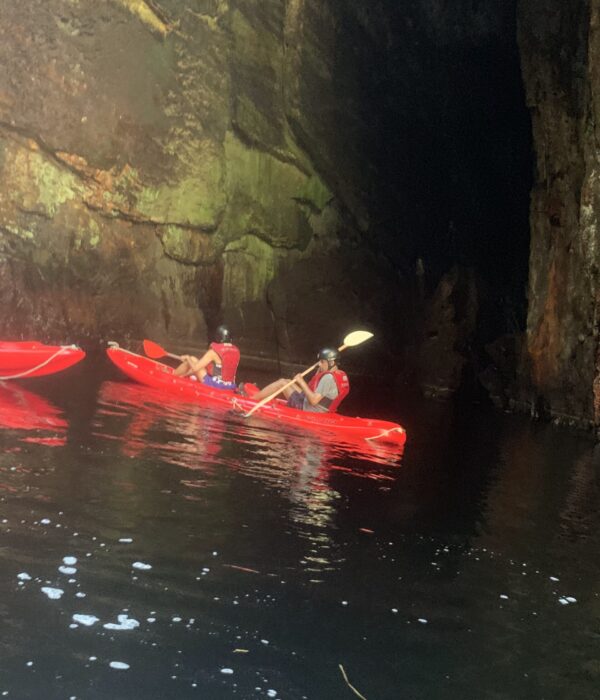
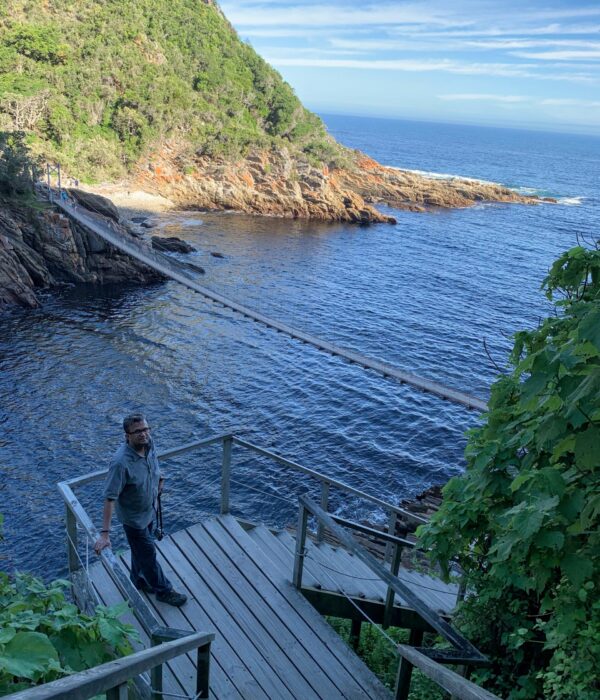
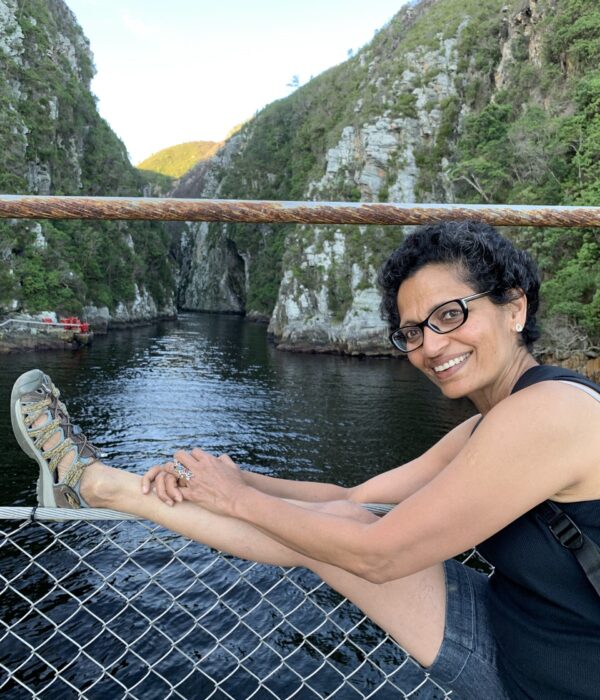
Day 4:
Ann and Lisa wanted a yoga class, so it was a great reason to wake up early and do a stretchy, restorative session on Ann’s deck overlooking the ocean. We then bid our goodbyes to our friends and stopped for a couple of hours at Nature’s Valley that lies between the Salt River, the foothills of the Tsitsikamma Mountains, the Indian Ocean and the Groot River lagoon.
The highlight of the day was our trip into Tsitsikamma National Park, especially the hike to the Storms River Suspension Bridge. There is so much to do in this protected park! Try the Lookout Trail, the Waterfall Trail, and the Lourie Trail, where you may be lucky enough to see whales.
The kayaking and Lilo (where we are lying on our stomachs and paddling with hands) is in the Storms River Gorge in the Tsitsikamma National Park where the river joins the ocean.
Day 5:
We were back in the Tsitsikamma National Park – to embark on a 2.5-hour kayak and lilo adventure up the Storms River Gorge. A lilo is a small inflatable raft that is capable of passing through narrow sections of river gorges. One lies on one’s belly and paddles with their hands (arm workout!).
The trip starts with kayaking across the ocean, passes under the famous Storms River Mouth Suspension Bridge (the same one we walked over the previous day), paddles into the Storm River to gaze at the tall cliffs, bat caves. The cliff jumping is optional, and of course, Chandru had to do it!
We used Untouched Adventures for this and they were an absolutely great company to work with. Make sure you take waterproof sandals for this adventure.
Lunch was at the Cattle Baron inside the national park with views to die for.
It was time to leave the gorgeous Tsitsikamma. We headed to the secluded Noetzie beach which is proudly encircled by castles. It is one of the last remaining homes for the very rare African Black Oystercatcher and is therefore a conservancy. There is (hidden) public access with steps leading down to the beach.
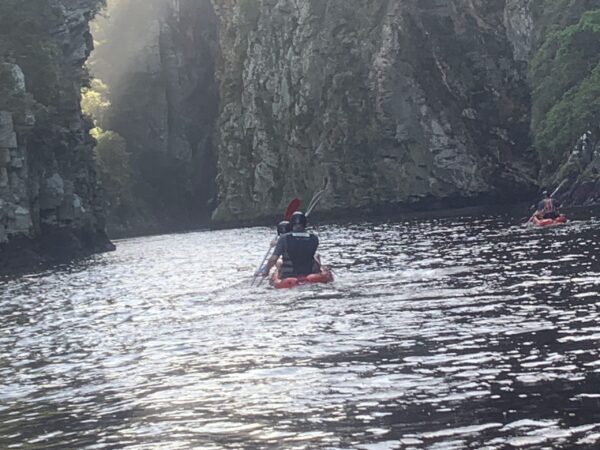
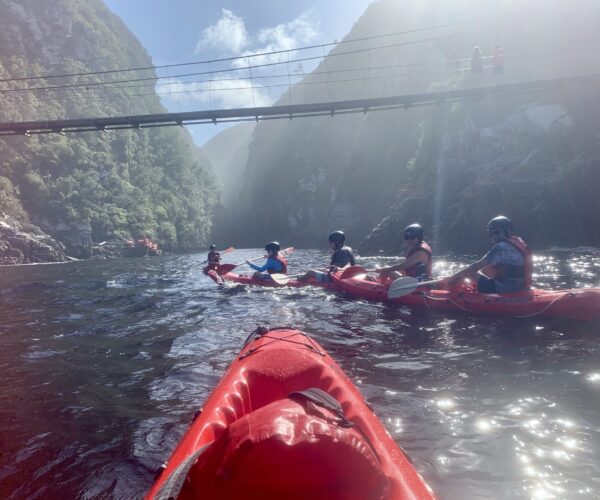
Day 6:
We headed out to our next point – Mossel Bay with a stop at the spectacular Cango Caves. Mossel Bay is a cute little town beach town with a lighthouse and great views all along and in town. This was our night halt, to break the long drive to Cape Town.
Day 7:
We drove the rest of the way to Cape Town via the beautiful vineyards of Heidelberg and Stellenbosch (known for its restored Cape Dutch architecture dating from the 18th and 19th centuries and for its streets lined with majestic oaks.). We visited the Drostdy Museum in Swellendam, famous from the Dutch East India times, strolled into small cafes, visited several artisans (picked up some cool stuff!). In another vineyard town of Franschhoek, we visited the lovely Haute Cabrière (established 1694) to sample their fine wines and tour their cellars. Sacred Ground (now sadly closed) was a great place to grab a bite to eat in the town of Franschhoek.
Finally, we reached the port city of Cape Town.
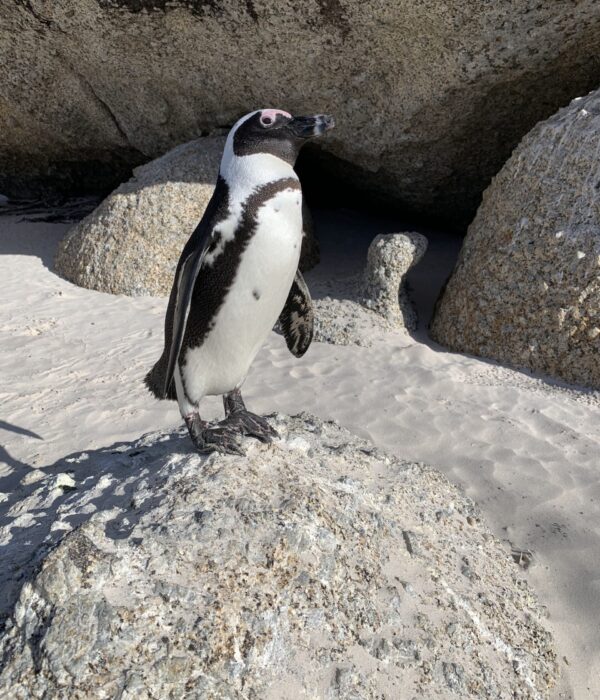
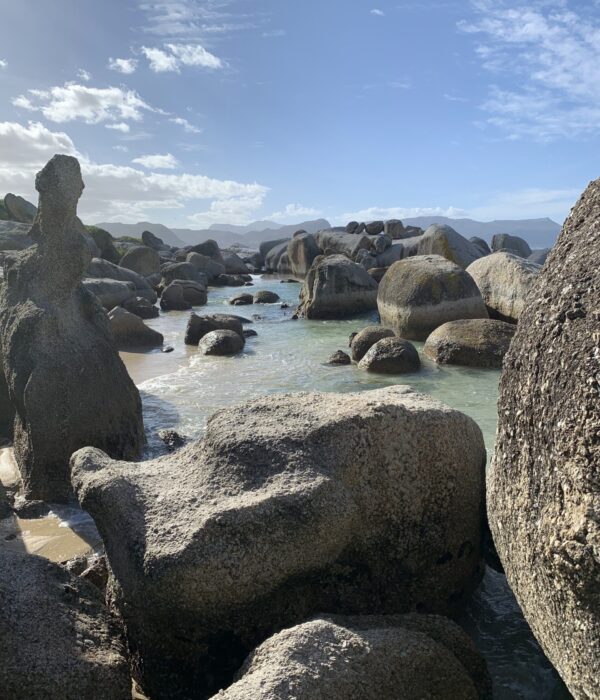
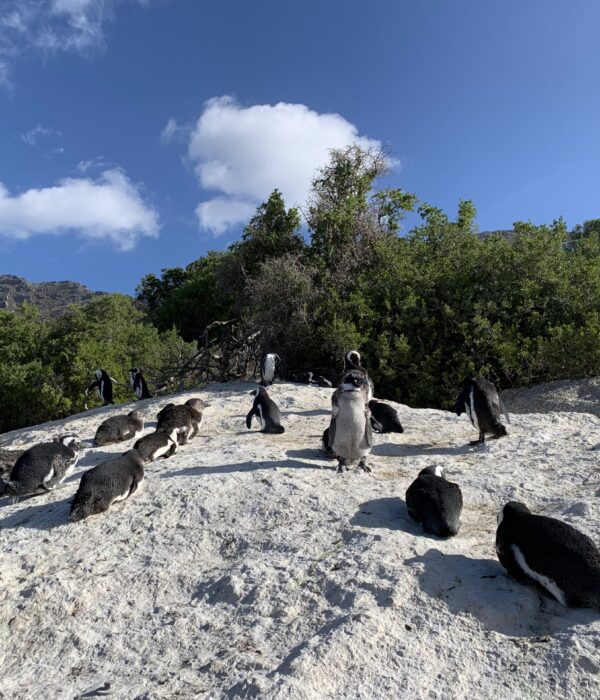
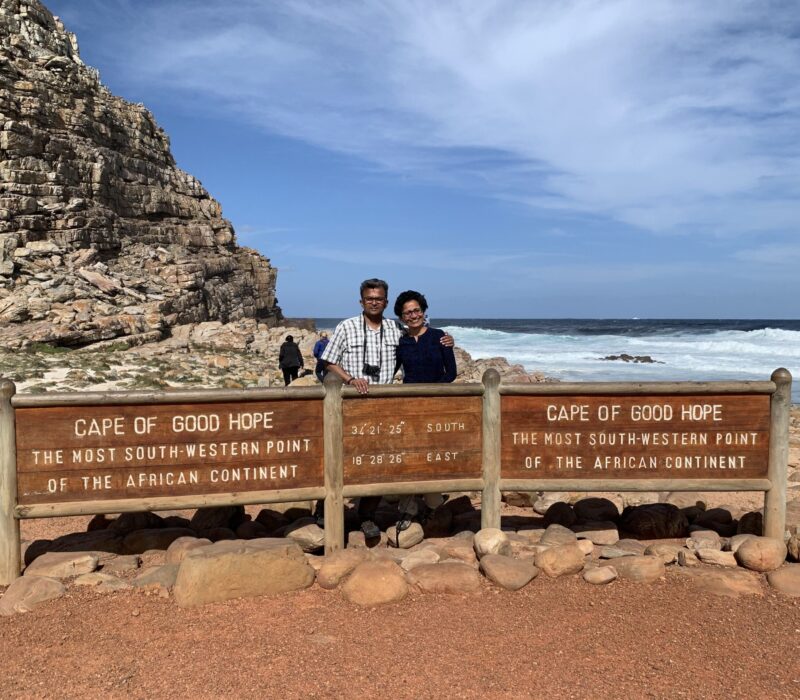
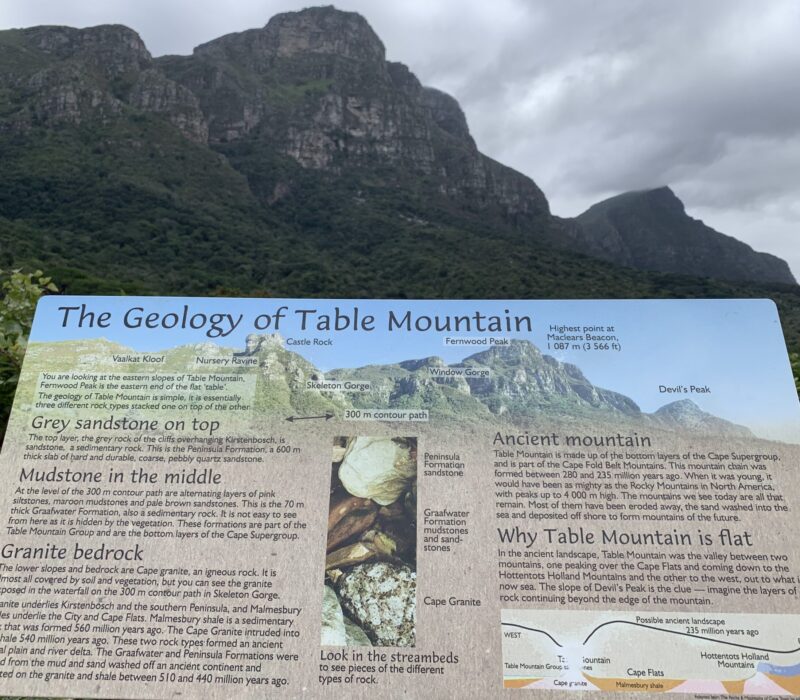
Day 8-10:
Cape Town is full of wonderful sights. I’ll list a few that I loved
- The world-famous Kirstenbosch National Botanical Garden. Set against the slopes of Table Mountain, this is an oasis of a wide variety of flora.
- Chapman’s Peak Drive – Rising from the ocean, this scenic mountain features a winding, coastal road with dramatic views.
- Boulders Beach – home to a unique and endangered land-based colony of African Penguins
- Robben Island – the place where Nelson Mandela, the first democratically elected president of South Africa, was imprisoned for 18 of his 27 years in jail.
- a ride-down on the Table Mountain Aerial Cableway and a hike up Table Mountain (we skipped in lieu of the Lion’s Head hike)
- Victoria and Alfred Waterfront – shopping, people watching, restaurants, water views
- Cape of Good Hope (Table Mountain National Park)
- Houses of Parliament
- 17th-century Castle of Good Hope (South Africa’s oldest building)
- Lively market at Greenmarket Square
- Zeitz Museum of Contemporary Art – world’s largest museumdedicated to contemporary art from Africa and its diaspora.
- Hike up Lion’s Head (amazing at night if there’s a full moon). This is a challenging hike so go prepared.
- The colorful houses in the Bo-Kaap neighborhood (formerly known as the Malay Quarter)
- The Flying Dutchman Funicular, also known as the Cape Point Funicular, is a funicular railway located at Cape Point, near the Cape of Good Hope in the Western Cape province of South Africa. The line runs from a lower station at the Cape Point car park, up an incline through dense fynbos to the upper lighthouse. Wikipedia
Address: Table Mountain National Park, Cape Point, Main Road, Cape of Good Hope, Simon’s Town, Cape Town, 7995, South Africa
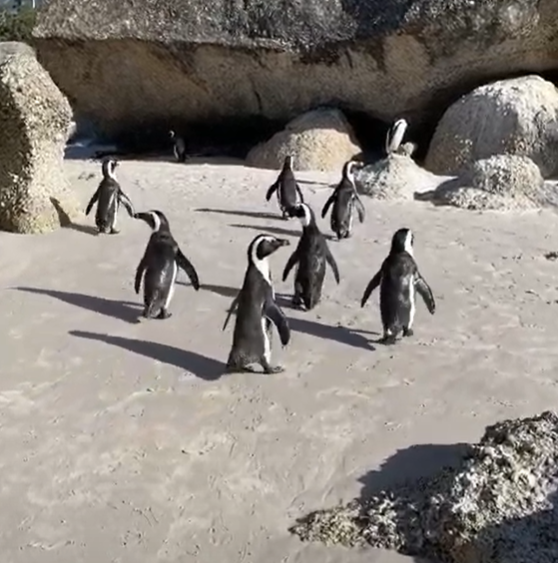
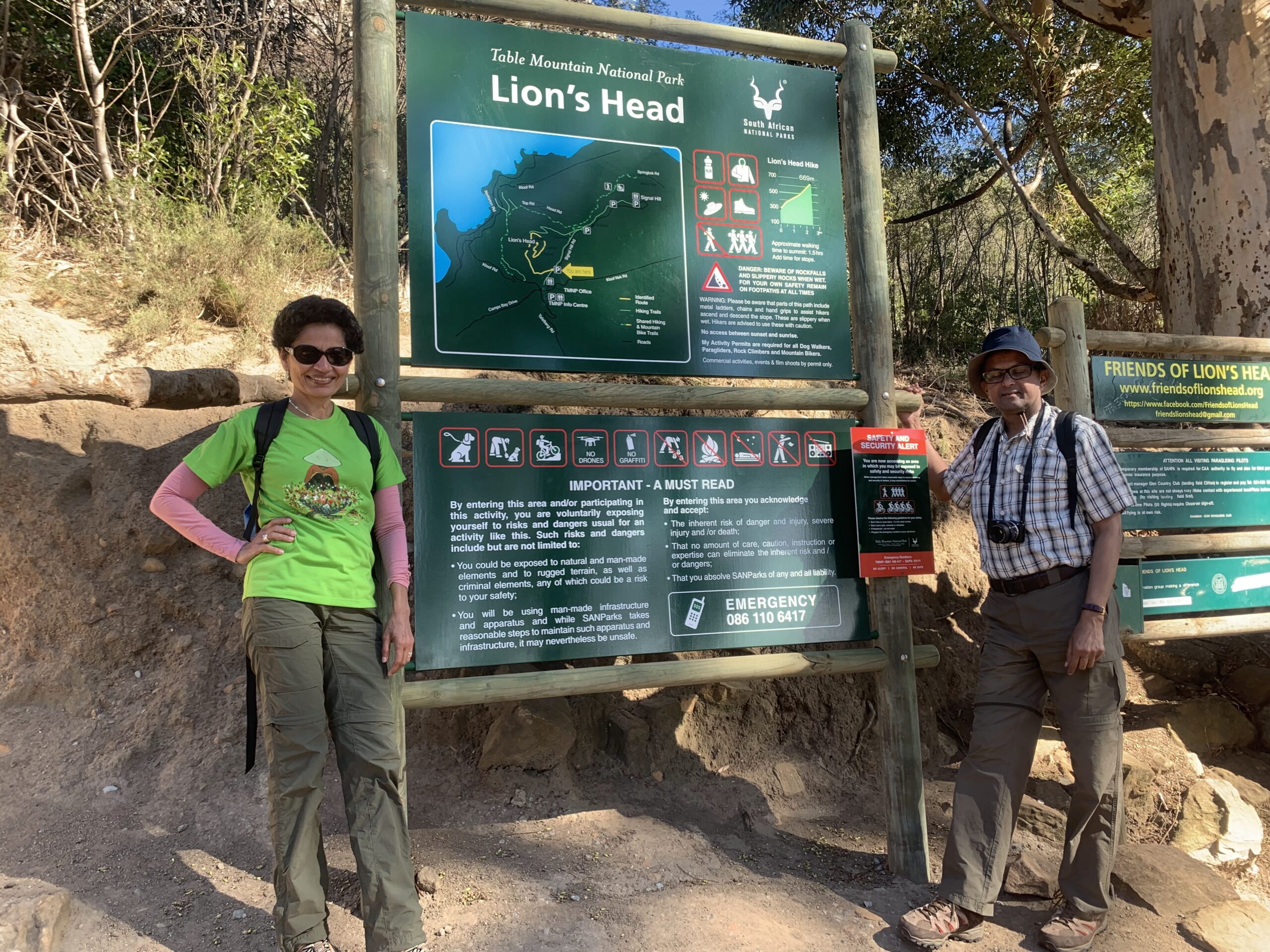
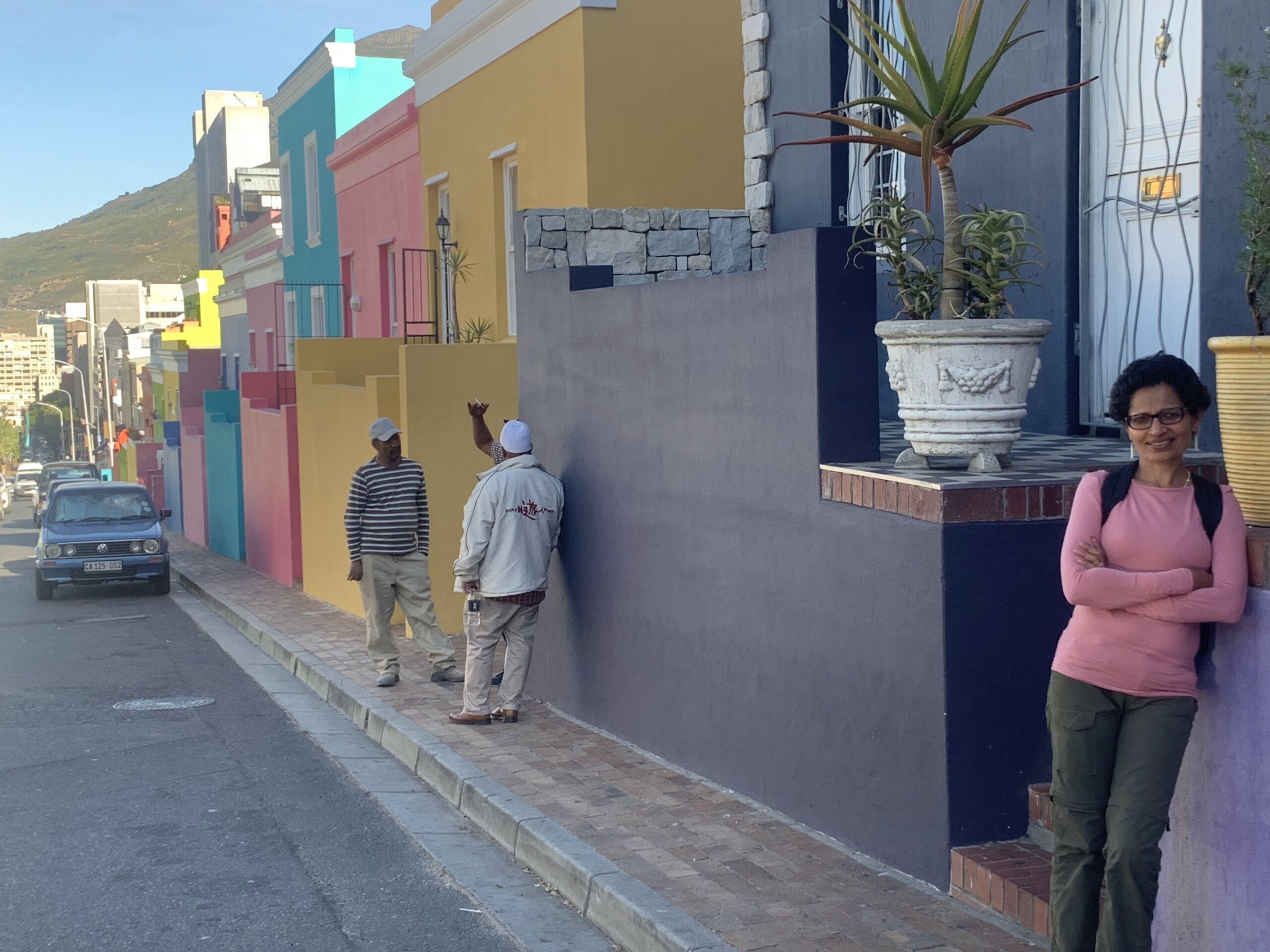
Free Subscribe
HOW YOU CAN SUPPORT THIS SITE
- Leave a comment on this page (scroll down), share your own experiences if you have already been to this place.
- Subscribe to travelstosavour and receive 2 free blog posts per month, featuring 2 new destinations (scroll down to the footer to subscribe).
- Follow travelstosavour on social media – Facebook, Instagram and Youtube (by a click of the button in the footer) and share all the goodies with your pals!
Check out other destinations and nature escapes on this site.


WANT A CUSTOM ITINERARY?
No time or inclination to delve into detailed vacation-planning? No worries!
Let’s talk…..I can curate and customize a day-by-day itinerary for you.
Remember to visit Services & About for more details.


